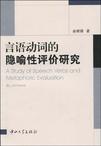言语动词的隐喻性评价研究
2009-7
中山大学
金娜娜
270
《言语动词的隐喻性评价研究》探讨言语动词在转述中的评价功能,是一部融合系统功能语言学与评价系统的理论探新之作。本研究从语义认知的思路探索言语动词在信息交流中的主观评价功能,建立了一个新的评价子系统,即隐喻性评价系统。基于若干语料的分析,《言语动词的隐喻性评价研究》揭示出,言语动词体现的隐喻性评价方式较其他评价方式在新闻报道和法庭语篇中表现更为突出。本研究拓展了功能语言学的研究视野,并为评价研究提供新的思路和方法。
金娜娜(1977- ),贵州贵阳人。1999年毕业于贵州大学外语系,获学士学位;2002年于江西师范大学外国语学院毕业,获英语语言文学硕士学位:2005年从厦门大学英语语言文学专业毕业,获博士学位。现为深圳大学外国语学院硕士生导师。研究方向为系统功能语言学、认知语言学和话语分析。曾先后在《外语教学与研究》、《外语教学》等国家级核心刊物上发表论文多篇,主编教材两部,参与翻译《麦克米伦高阶英汉双解词典》,并多次参加国内外相关学术会议并宣读论文,为中国功能语言学学会理事。已经主持完成深圳大学社科课题一项、教研课题一项,现主要负责深圳大学精品课程建设项目。
AcknowledgementsList of Figures and Tables Introduction 1 The background of the research2 The research purposes and significance3 The research methodology and data collection4 The organization of this bookChapter 1 Previous Studies of Speech Verbs and EvaluationI.1 IntroductionI.2 The definition of speech verbsI.3 Four major approaches to speech verbs1.3.1 The first major approach: the traditional approach 1.3.2 The second major approach: Speech Act Theory 1.3.3 The third major approach: statistics1.3.4 The fourth major approach: Systemic Functional Grammar1.4 Two major approaches to evaluation1.4.1 The philosophical approach1.4.2 The linguistic approach1.4.3 Two major linguistic frameworks of evaluation1.5 The shortcomings of previous studies1.6 SummaryChapter 2 Speech Verbs and the Reporting Nature2.1 Introduction2.2 A new classification of speech verbs2.3 The syntactic properties of speech verbs2.3.1 The addresser: Sayer2.3.2 The addressee: Receiver2.3.3 Sentence frames2.3.4 "Wh-" words2.4 The reporting nature of speech verbs2.4.1 Speech verbs and reporting2.4.2 Direct speech and indirect speech2.4.3 The performative function of reporting2.5 The performances of speech verbs2.5.1 Speech verbs and a speaker/writers responsibility2.5.2 Speech verbs as hearsay markers2.6 SummaryChapter 3 Metaphoric Evaluation3.1 Introduction3.2 Grammatical metaphor: the basis of metaphoric evaluation3.2.1 Ideational metaphor……Chapter 4 A Study of Speech Verbs Below the ClauseChapter 5 A Study of Speech Verbs Above the Clause and Beyond the ClauseConclusionAppendix 1 The Classification of 236 Speech Act Verbs by WierzbickaAppendix 2 The Senses of Apply Given by WordNet2.0Appendix 3 The Appication of Words LocationAppendix 4 Sample Concoreance Lines for SayAppendix 5 Data SamplesBibliography
